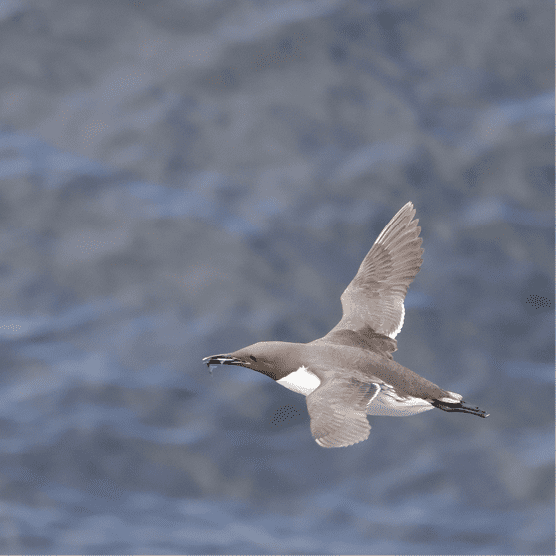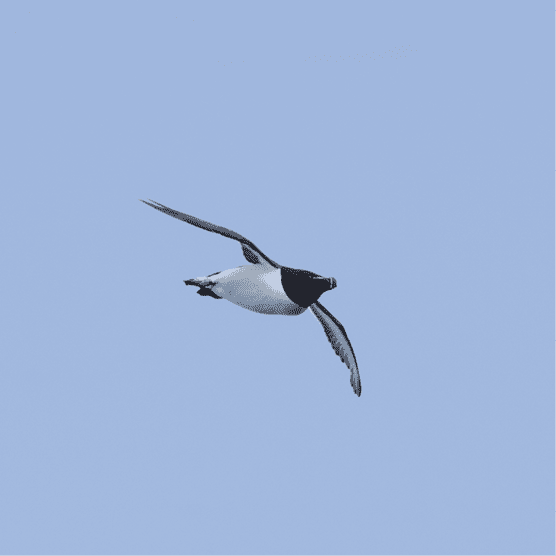Winter storms are a frequent occurrence on Ireland’s Atlantic coastline. In the aftermath of Storm Éowyn, the power of these storms and the damages they can incur is particularly apparent. Climate models suggest that continued warming of the oceans could increase the number and intensity of these storms that batter Ireland over the winter months. In addition to wreaking havoc on homes and businesses up and down the country, these storms also affect the lives of the seabirds that spend their winters feeding along our shores and out in the North Atlantic.
Stormy conditions at sea increase the energy seabirds must expend to travel and find food. By decreasing underwater visibility and driving prey species deeper these storms and the turbulent water they bring with them make foraging at sea much more difficult. Inexperienced young birds are especially at risk of succumbing to starvation and exhaustion during stormy weather due to the higher energy demands of flying in search of food through high winds and turbulence. In extreme cases seabirds may even be at risk of collision with structures or debris in intense winds, this threat is especially apparent when chicks have recently left the nest.
An example of this effect was seen in 2014 on Rockabill Island in county Dublin, following a two to four-week period of frequent storms early in the year the population of Black Guillemot breeding on the island was reduced by half, from 90 pairs down to 45 pairs. This stormy weather affected seabirds across Western Europe and resulted in the deaths of thousands of seabirds throughout the Irish Sea and the Bay of Biscay. Breeding populations of Common Guillemot, Black Guillemot, Razorbill and Puffin all saw reductions following the stormy spell of weather.
A study carried out on Skomer Island in Wales closely monitored the movements, habits and populations of Common Guillemot, Razorbill, and Puffin (long-lived species which spend their winters at sea) between the 1970s and 2020s. Through assessing the populations of these species in tandem with detailed meteorological data it was found that the survival of Guillemot and Razorbill was lowest in stormier winters and were particularly affected during winters that had more windy days. The lowest survival of puffins over winter was observed during the stormy spell in 2014, the intensity of storms wasn’t as strongly correlated with puffin survival, however, the gaps between storms seemed to play an important role. In winters where storms were spread more widely apart puffins faired better, and in winters where gaps between storms were shorter puffin survival decreased.
The increasing severity and frequency of winter storms, linked to the changing climate, places additional pressures and threats on seabird populations living in the North Atlantic and along the Irish coastline.
Photo credit: Luke Lambert, MKO Ornithologist
References:
Laurenson, K., Wood, M.J., Birkhead, T.R., Matthew, Sherley, R.B., Fayet, A.L., Guilford, T., Hatchwell, B.J. and Votier, S.C. (2024). Long‐term multi‐species demographic studies reveal divergent negative impacts of winter storms on seabird survival. Journal of Animal Ecology. Wiley. doi:https://doi.org/10.1111/1365-2656.14227
Skillen, R. (2023). What storms mean for seabirds. [online] BirdWatch Ireland. Available at: https://birdwatchireland.ie/what-storms-mean-for-seabirds/
Clairbaux, M., Mathewson, P., Porter, W., Fort, J., Strøm, H., Moe, B., Fauchald, P., Descamps, S., Helgason, H.H., Bråthen, V.S., Merkel, B., Anker-Nilssen, T., Bringsvor, I.S., Chastel, O., Christensen-Dalsgaard, S., Danielsen, J., Daunt, F., Dehnhard, N., Erikstad, K.E. and Ezhov, A. (2021). North Atlantic winter cyclones starve seabirds. Current Biology, 31(17), pp.3964-3971.e3. doi: https://doi.org/10.1016/j.cub.2021.06.059





